3C 产品的电池种类介绍
电池知识大全

电池知识大全电池是一种能够将化学能转化为电能的装置,被广泛应用于各种电子设备、交通工具和能源储备系统中。
下面是关于电池的综合知识大全,涵盖了电池的种类、工作原理、应用领域以及相关的环保和安全问题。
一、电池的种类1. 干电池:干电池是一种不可充电的电池,内部使用干态电解质。
最常见的干电池包括碱性电池(如碱性锰电池)、锌碳电池和银氧化锌电池。
2. 镍镉电池(Ni-Cd电池):镍镉电池是一种可充电电池,由金属镍、金属镉和碱性电解液构成。
它具有较高的能量密度和较长的寿命,但含有有毒的重金属镉,对环境造成污染。
3. 镍氢电池(Ni-MH电池):镍氢电池是一种可充电电池,使用金属氢化物作为负极材料,金属镍作为正极材料,碱性电解液导电。
相较于镍镉电池,镍氢电池具有更高的能量密度和较少的环境污染。
4. 锂离子电池(Li-ion电池):锂离子电池是一种常见的可充电电池,使用锂离子在正负极之间的迁移实现电荷和放电。
它具有高能量密度、轻量化和无记忆效应等优点,在移动设备、电动汽车等领域得到广泛应用。
5. 钠离子电池(Na-ion电池):钠离子电池类似于锂离子电池,但使用钠离子作为电荷的传输媒介。
相较于锂离子电池,钠离子电池有较低的成本和更广泛的资源供应,但能量密度稍低。
6. 燃料电池:燃料电池将化学能直接转化为电能,通常使用氢气作为燃料和氧气作为氧化剂。
燃料电池具有高效率、无污染排放和可持续性等优点,适用于电动汽车和能源储备系统。
二、电池的工作原理电池的工作原理基于电化学反应。
它由两个电极(正极和负极)以及介于两者之间的电解质组成。
当电池连接外部电路时,化学反应发生,产生电流。
1. 非可充电电池工作原理:- 正极反应:正极材料中的化学物质氧化,释放出电子和金属离子。
例如,在碱性锰电池中,正极材料为二氧化锰(MnO2),反应为:MnO2 + H2O + e- → MnO(OH) + OH-- 负极反应:负极材料中的化学物质还原,吸收电子。
电池型号大全

电池型号大全电池是现代生活中不可或缺的电源设备,它们广泛应用于手机、笔记本电脑、数码相机、手持游戏机等各种便携式电子设备中。
不同的电子设备需要不同规格的电池,因此了解各种电池型号及其特性对我们选择合适的电池至关重要。
本文将为大家介绍一些常见的电池型号,帮助大家更好地了解电池。
1. AA电池。
AA电池是一种常见的碱性电池,也被称为干电池。
它们通常用于遥控器、闹钟、手电筒等家用电器中。
AA电池的直径为14.5毫米,长度为50.5毫米,是一种标准尺寸的电池。
2. AAA电池。
AAA电池是AA电池的小尺寸版本,直径为10.5毫米,长度为44.5毫米。
它们通常用于一些较小的电子设备,如数码相机、电子玩具等。
3. 锂离子电池。
锂离子电池是一种充电电池,具有高能量密度、长寿命和轻量化的特点。
它们广泛应用于手机、笔记本电脑、平板电脑等移动设备中。
常见的锂离子电池型号包括18650、14500、16340等。
4. 镍氢电池。
镍氢电池是一种环保型充电电池,具有高容量、低内阻、无记忆效应等特点。
它们通常用于数码相机、手持游戏机、便携式音响等设备中。
常见的镍氢电池型号包括AA、AAA、9V等。
5. 纽扣电池。
纽扣电池又称为扣式电池,是一种小型圆形电池,直径一般在5-25毫米之间。
它们通常用于手表、遥控器、体温计等小型电子设备中。
常见的纽扣电池型号包括CR2032、CR2025、LR44等。
6. 聚合物锂离子电池。
聚合物锂离子电池是一种新型的锂离子电池,具有更高的安全性和稳定性。
它们通常用于一些对安全性要求较高的设备,如无人机、电动汽车等。
常见的聚合物锂离子电池型号包括3.7V 10000mAh、3.8V 5000mAh等。
7. 铅酸蓄电池。
铅酸蓄电池是一种成熟的蓄电池技术,具有低成本、高循环寿命等优点。
它们通常用于应急照明、UPS电源、太阳能储能系统等领域。
常见的铅酸蓄电池型号包括12V 7Ah、6V 4.5Ah等。
以上就是一些常见的电池型号及其应用领域,希望能够帮助大家更好地了解电池。
电池类型规范
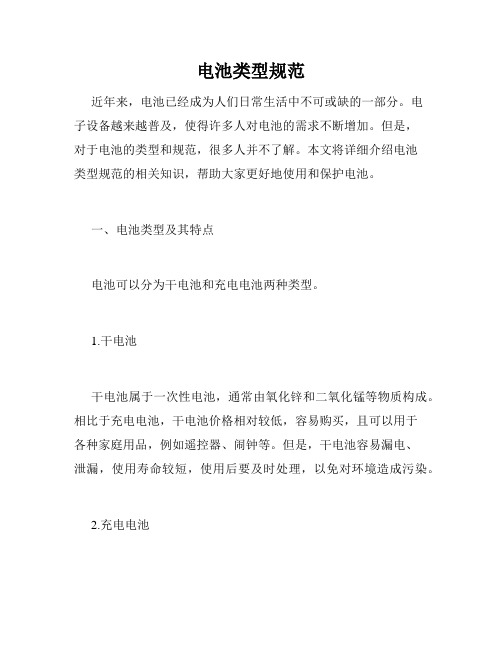
电池类型规范近年来,电池已经成为人们日常生活中不可或缺的一部分。
电子设备越来越普及,使得许多人对电池的需求不断增加。
但是,对于电池的类型和规范,很多人并不了解。
本文将详细介绍电池类型规范的相关知识,帮助大家更好地使用和保护电池。
一、电池类型及其特点电池可以分为干电池和充电电池两种类型。
1.干电池干电池属于一次性电池,通常由氧化锌和二氧化锰等物质构成。
相比于充电电池,干电池价格相对较低,容易购买,且可以用于各种家庭用品,例如遥控器、闹钟等。
但是,干电池容易漏电、泄漏,使用寿命较短,使用后要及时处理,以免对环境造成污染。
2.充电电池充电电池可以反复充电使用,分为镉镍电池、镉镍金属氢化物电池和锂离子电池三种类型。
(1)镉镍电池镉镍电池也称为液态电池,较为常见。
它的优点是价格便宜、容易购买,且使用寿命较长。
但是,镉镍电池容易出现“记忆效应”,使用寿命受到限制,且内部材料含有有害元素,使用后也会对环境造成影响。
(2)镉镍金属氢化物电池镉镍金属氢化物电池类似于镉镍电池,但内部材料不含有毒性物质,对环境影响更小。
使用寿命较长,但价格相对较高,常见于较高档次的电子设备。
(3)锂离子电池锂离子电池作为目前电池产业的主力军,不但在电子设备领域广泛应用,还可以用于电动车、储能装置等多个领域。
锂离子电池具有使用寿命较长、体积小、重量轻等特点。
但是,锂离子电池的价格相较于其他电池较高,且锂离子电池容易爆炸等安全问题使得其应用受到一定限制。
二、电池规范及注意事项随着电池需求的不断增加,电池的规范也越来越受到关注。
为了使用电池更加安全、稳定,我们需要遵循以下规范及注意事项。
1.选购电池要遵循“优先选用原装电池,次选品牌电池”的原则。
不同电子产品对电池的要求不同,因此购买电池时要选择符合电子产品规定的电池型号,避免因电池不匹配而对电子产品造成损害。
另外,尽量选择原装电池。
如果原装电池价格过高,可以选用品牌电池,但在选用非原装电池时,要确保其质量可靠,并且避免购买劣质电池。
6大锂电池类型及性能参数!

6大锂电池类型及性能参数!锂电池是一种使用锂盐作为正极和负极活性物质的电池,被广泛应用于移动电子设备、电动车辆和储能系统等领域。
根据不同的电极材料和电解质,锂电池可以分为不同类型,在性能参数上也有所差异。
下面将介绍6种主要的锂电池类型及其性能参数。
1. 锂离子电池(Li-ion)锂离子电池是目前最常见的锂电池类型,其正极材料通常为氧化锂钴酸锂(LiCoO2)、磷酸铁锂(LiFePO4)等。
电解液一般是有机溶剂,如碳酸酯类。
锂离子电池具有高能量密度、长循环寿命和低自放电率等优点。
其性能参数包括能量密度、循环寿命、充放电效率等。
2.锂聚合物电池(LiPo)锂聚合物电池是一种使用聚合物电解质的锂电池,具有高能量密度、薄、轻和灵活等特点。
锂聚合物电池常用于手持设备和无人机等领域。
性能参数包括能量密度、循环寿命、安全性等。
3.磷酸铁锂电池(LiFePO4)磷酸铁锂电池是一种以磷酸铁锂作为正极材料的锂电池,具有高安全性、长循环寿命和良好的耐高温性能。
磷酸铁锂电池适用于电动车辆和储能系统等高功率应用场景。
性能参数包括循环寿命、充放电效率、安全性等。
4.钴酸锂电池(LiCoO2)钴酸锂电池是一种使用钴酸锂作为正极材料的锂电池,具有高能量密度和良好的性能稳定性。
钴酸锂电池适用于便携式电子设备和医疗器械等领域。
性能参数包括能量密度、循环寿命、充放电效率等。
5.氧化镍锰钴电池(NMC)氧化镍锰钴电池是一种复合正极材料的锂电池,具有高能量密度和安全性。
氧化镍锰钴电池广泛应用于电动车辆和储能系统等领域。
性能参数包括循环寿命、充放电效率、安全性等。
6.三元锂电池(LTO)三元锂电池以氧化锂钴酸锂为正极材料,以石墨和C-LiFePO4为负极材料,电解质为含有锂盐的有机碳酸酯类液体电解质。
其具有高充放电速率、良好的循环寿命和优秀的安全性能。
适用于高功率应用场景,如电动车辆和储能系统。
性能参数包括充放电效率、循环寿命、安全性等。
3c电池类三元正极材料
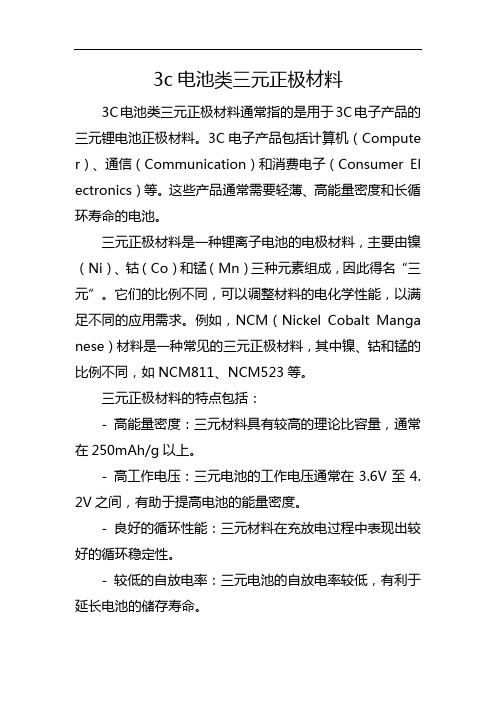
3c电池类三元正极材料
3C电池类三元正极材料通常指的是用于3C电子产品的三元锂电池正极材料。
3C电子产品包括计算机(Compute r)、通信(Communication)和消费电子(Consumer El ectronics)等。
这些产品通常需要轻薄、高能量密度和长循环寿命的电池。
三元正极材料是一种锂离子电池的电极材料,主要由镍(Ni)、钴(Co)和锰(Mn)三种元素组成,因此得名“三元”。
它们的比例不同,可以调整材料的电化学性能,以满足不同的应用需求。
例如,NCM(Nickel Cobalt Manga nese)材料是一种常见的三元正极材料,其中镍、钴和锰的比例不同,如NCM811、NCM523等。
三元正极材料的特点包括:
- 高能量密度:三元材料具有较高的理论比容量,通常在250mAh/g以上。
- 高工作电压:三元电池的工作电压通常在3.6V至4. 2V之间,有助于提高电池的能量密度。
- 良好的循环性能:三元材料在充放电过程中表现出较好的循环稳定性。
- 较低的自放电率:三元电池的自放电率较低,有利于延长电池的储存寿命。
在3C电子产品中,三元正极材料被广泛应用,尤其是在笔记本电脑、智能手机和平板电脑等设备中。
随着新能源汽车的兴起,三元正极材料在电动汽车电池中的应用也越来越广泛。
然而,三元正极材料也存在一些挑战,如成本较高、钴资源稀缺、高温下的循环稳定性和安全性问题等。
为了克服这些挑战,研究人员正在探索替代材料,如富锂材料、硅基负极材料等,以及改进电池设计和制造工艺,以提高电池的性能和降低成本。
6大锂电池类型及性能参数汇总!

6大锂电池类型及性能参数汇总!我们常常会说到三元锂电池或者铁锂电池,这些都是按照正极活性材料来给锂电池命名的。
常见六种锂电池具体包括:钻酸锂,镒酸锂,锲钻镒酸锂(NCM),银钻铝酸锂(NCA),磷酸铁锂,钛酸锂。
一、钻酸锂(LiCoO2)其高比能量使钻酸锂成为手机,笔记本电脑和数码相机的热门选择。
钻酸锂的缺点是寿命相对较短,热稳定性低和负载能力有限(比功率)。
像其他钻混合锂离子电池一样,钻酸锂采用石墨负极,其循环寿命主要受到固体电解质界面(SEl)的限制,主要表现在S日膜的逐渐增厚,和快速充电或者低温充电过程的负极镀锂问题。
较新的材料体系增加了模,镒和/或铝以提高寿命,负载能力和降低成本。
图1平均钻酸锂电池的蜘蛛图六角蜘蛛图总结了与运行相关的具体能量或容量方面的钻酸锂性能。
钻酸锂在高比能量方面表现出色,但在功率特性、安全性和循环寿命方面只能提供一般的性能表现。
电区标称值为3. 60V;典型工作范围3∙ 0-4. 2V /电池比能150-200Wh ∕kgβ特和电池提供南达240Wh / kg.充电0.7-1C,充电至4.20V (大部分电池);典型充电时■长3小时;IC以上的充电电流会缩短电池寿命。
放电1C;放也截止电区2.50V。
IC以上的放电电潦会蝮短电池寿命。
桃环寿命500-1000,与放电深度,负荷,温生有关然失控150, C (302* F)。
满充枚态容易带来热失控应用手机,手板电脑,笔记本电脑,相机注释非常市的比能量.有限的比功率.话很昂贵。
被用作能量型电池・市场份领稳定。
表2钻酸锂的特性二、镒酸锂(LiMn2O4)尖晶石镒酸锂电池首次发表于1983年的材料研究报告中。
1996 年,MOIi能源公司将镒酸锂为正极材料的锂离子电池商业化。
该架构形成三维尖晶石结构,可改善电极上的离子流动,从而降低内部电阻并改善电流承载能力。
尖晶石的另一个优点是热稳定性高,安全性提高,但循环和日历寿命有限。
电池的种类都有哪些?

电池的种类都有哪些?电池主要有碱性电池、碳性电池等,这些电池因为其里面成分的不同会对其性能以及使用方法产生差异。
随着电池行业的发展,电池开始变得越来越小,电量越来越大,电压越来越大。
1、碳性电池一次电池,电压:1.5V锌锰电池,俗称碳性电池。
日常生活中常用的干电池。
是目前最便宜的一种电池。
这种电池容量低,容易漏液。
目前常见于电视遥控器等产品里使用。
常见产品:1号、2号、5号、7号、纽扣式等。
2、碱性电池一次电池,电压:1.5V碱性电池是目前最常用的电池。
优点在于耐久的电量,可以做到碳性电池电量的7倍。
电流输出稳定,不漏液。
可用于耗电量比较大的仪器设备里使用。
常见产品:1号、2号、5号、7号、纽扣式等。
3、镍镉电池可充电电池,电压:1.2V镍镉电池的缺点:体积大、分量重、容量小、自放电、有记忆效应、不环保。
优点在于:可以反复充电500次以上,非常经济。
耐过冲过放,使用操作简单。
内阻小,可以大电流放电,所以该产品常见于电动工具重使用。
常见产品:1号(D型)、2号(C型)、5号(AA)、7号(AAA)、纽扣式和各种非标型号。
4、镍氢电池可充电电池,电压:1.2V镍氢电池和镍镉电池比较下缺点在于不能大电流放电(目前已经有工厂生产大电流放电的镍氢电池)。
优点在于同样体积容量高出镍镉一倍以上,记忆效应小,无污染称为绿色环保电池。
常见产品:1号(D型)、2号(C型)、5号(AA)、7号(AAA)、纽扣式和各种非标型号。
5、锂离子电池电压:3.7V锂离子电池外壳有钢壳和铝壳,铝壳比钢壳容量高10%--15%优点:体积小,容量高,电压高。
形状有柱形,方形,异形。
常用于手机电池,PDA电池,笔记本电脑电池。
电池主要有五种,碳性电池、碱性电池、镍镉电池、镍氢电池和锂电子电池。
其中锂电子电池常用于手机和电脑,其体积是极小的,但是所贮存的电量是很大。
常用电池的类型及特点

常用电池的类型及特点01干电池干电池是一种以糊状电解液来产生直流电的化学电池(湿电池则为使用液态电解液的化学电池),干电池是一次电池,是日常生活之中为普遍使用,以及轻便的电池。
它可在实验室内自制的电池们可以使用于很多电器用品上。
常见的干电池为锌锰电池(或称碳锌电池)。
干电池属于化学电源中的原电池,是一种一次性电池。
干电池不仅适用于手电筒、半导体收音机、收录机、照相机、电子钟、玩具等,而且也适用于国防、科研、电信、航海、航空、医学等国民经济中的各个领域,十分好用。
02锂电池锂电池是一类由锂金属或锂合金为负极材料、使用非水电解质溶液的电池。
锂电池大致可分为两类:锂金属电池和锂离子电池。
锂离子电池不含有金属态的锂,并且是可以充电的。
(1)优点※能量比较高。
※使用寿命长,使用寿命可达到6年以上。
※额定电压高(单体工作电压为3.7V或3.2V)。
※具备高功率承受力。
※自放电率很低。
※重量轻。
※高低温适应性强。
※绿色环保,不论生产、使用和报废,都不含有、也不产生任何铅、汞、镉等有毒有害重金属元素和物质。
※生产基本不消耗水,对缺水的我国来说,十分有利。
(2)缺点●锂原电池均存在安全性差,有发生爆炸的危险。
●钴酸锂的锂离子电池不能大电流放电,价格昂贵,安全性较差。
●锂离子电池均需保护线路,防止电池被过充过放电。
●生产要求条件高,成本高。
●使用条件有限制,高低温使用危险大。
03蓄电池蓄电池是将化学能直接转化成电能的一种装置,是按可再充电设计的电池,通过可逆的化学反应实现再充电,也称二次电池。
它的工作原理:充电时利用外部的电能使内部活性物质再生,把电能储存为化学能,需要放电时再次把化学能转换为电能输出,比如生活中常用的手机电池等。
蓄电池是世界上广泛使用的一种化学“电源”,具有电压平稳、安全可靠、价格低廉、适用范围广、原材料丰富和回收再生利用率高等优点,是世界上各类电池中产量最大、用途最广的一种电池。
04太阳能电池太阳能电池又称为“太阳能芯片”或“光电池”,是一种利用太阳光直接发电的光电半导体薄片。
3C产品的电池种类介绍
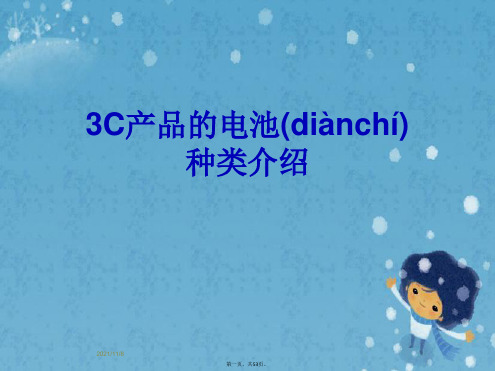
第四页,共53页。
效率高, 乾淨
▪ 傳統內燃機﹝發電機﹞要將例如煤、燃油、瓦斯等物質的化 學能轉變為電能的發電過程,是由燃料混合氧、先轉變為熱 能、機械能,再轉變為電能的複雜顺序,因此普通只需30% 左右的效率。 反之,燃料電池的能量轉換效率十分高,它是运用輸入燃料 混合氧,不經過轉換機械能便能持續產生熱能及電力,也不 須傳統二次電池所需的充放電顺序。以氫氣及氧氣為燃料, 运用觸媒减速反應速率,燃料電池可直接將化學能轉變為電 能,其效率可接近40%,假定再包括回收餘熱,效率更可輕 易超過65%。而且只需正常运用下,燃料提供無虞,目前依 照官方說法並無运用時間上的限制(xiànzhì)。
▪ 此外太陽能的應用又可分為熱能的 "太陽能熱水器" 及光直 接轉換電的 "太陽能電池" , 目前較著重於 "太陽能 電池" 的應用推展.
▪ 普通所講的或能買到的太陽能光電池(Solar cell),並不同 於普通"蓄電池"〔Battery〕可儲存電能,而是有光源照射 的當時,才干將光能轉換為電壓與電能並可立刻輸出的電 池(Cell),因其自身並非儲能蓄電池,故無法儲存電能
multi-year service and have moderate specific energy.
第十页,共53页。
▪ Second-generation zinc-air (GEN 2) is the button-cell, commercialized in the 1970’s for hearing aids (Figure 2). With specific energies of more than 400 Wh/kg, the button cell is typically limited to about 10 mW in power and has a service life of one month.
2024年3C锂电池市场规模分析

2024年3C锂电池市场规模分析1. 引言3C锂电池(指用于消费电子产品、通信设备和计算机等的锂离子电池)是一种非常普遍的电池类型,在现代社会中得到了广泛应用。
本文将对3C锂电池市场规模进行分析,以了解其当前的市场情况和未来的发展趋势。
2. 市场概况3C锂电池市场是一个持续增长的市场,在过去几年中经历了快速发展。
其主要驱动因素包括消费电子产品的普及、通信设备的快速发展以及计算机技术的进步等。
目前,3C锂电池市场已经形成了一个庞大的规模,涵盖了多个领域和细分市场。
3. 市场规模分析3.1 产品类型分析3C锂电池市场主要包括手机电池、笔记本电池、平板电脑电池、相机电池等多种产品类型。
根据市场数据统计,手机电池是3C锂电池市场中最大的产品类型,占据了市场份额的大部分。
其次是笔记本电池和平板电脑电池,相机电池的市场份额相对较小。
3.2 市场地区分析3C锂电池市场在全球范围内都有着广泛的需求和应用。
根据市场研究报告,亚洲地区是3C锂电池市场最大的地区,其市场规模超过了其他地区的总和。
欧洲和北美地区紧随其后,市场规模均较大。
其他地区的市场规模相对较小,但也在不断增长。
3.3 市场竞争分析3C锂电池市场存在着激烈的竞争。
目前,市场上有许多厂商在生产和销售3C锂电池产品。
这些厂商之间竞争激烈,主要通过技术创新、产品质量、价格竞争和市场营销等方面来争夺市场份额。
大型厂商具有规模经济效应和品牌影响力,但小型企业也能够通过专业化和差异化战略来获得一定的市场份额。
4. 市场发展趋势4.1 技术创新随着科技的不断进步,3C锂电池市场将继续迎来新的技术创新。
这些技术创新将致力于提高电池的续航能力、充电速度和安全性能。
同时,新材料的研发和应用也将推动3C锂电池市场的发展。
4.2 新兴应用领域除了传统的消费电子产品、通信设备和计算机市场,3C锂电池市场还有巨大的发展空间。
例如,无人机、智能穿戴设备、电动汽车等新兴应用领域对3C锂电池的需求不断增长,将成为市场的新的增长点。
电池的种类 原电池和可充电电池

电池的种类原电池和可充电电池电池的种类:原电池和可充电电池电池是一种将化学能转换为电能的设备,被广泛应用于各个领域,如家庭电器、通信设备、汽车等。
根据其性质和用途的不同,电池可分为原电池和可充电电池两种主要类型。
一、原电池原电池,也称为非充电电池或干电池,是一次性使用的电池。
一旦原电池的储能被耗尽,就无法再充电或维修,需要更换新的电池。
原电池的结构简单,便于使用,常见的原电池有碳锌电池、碱性电池和锂电池。
1. 碳锌电池碳锌电池是最早应用于市场的原电池之一。
它由一个碳棒作为负极,一个锌罐作为正极,之间由一定浓度的酸性电解液分隔。
碳锌电池的优点是价格低廉,但容量较小,能量密度相对较低。
2. 碱性电池碱性电池是一种改进型的原电池,其在结构上与碳锌电池相似,但使用了碱性电解液。
相比碳锌电池,碱性电池具有更高的能量密度和更长的使用寿命,能够在高负载和较低温度下提供稳定的电力输出。
3. 锂电池锂电池是一种高性能的原电池,已广泛应用于电子产品领域。
锂电池的正极采用锂化合物,负极则由碳材料构成。
锂电池具有高能量密度、轻量化和长寿命的特点,在移动设备、无人机和新能源汽车等领域得到广泛运用。
二、可充电电池可充电电池,也称为蓄电池或二次电池,与原电池不同,可充电电池能够通过外部电源进行充电,使其恢复储能状态。
可充电电池的使用寿命比原电池长,能够循环充放电多次,减少了对环境的影响。
1. 铅酸蓄电池铅酸蓄电池是一种最常见的可充电电池,其正极和负极均由铅和铅氧化物构成。
铅酸蓄电池广泛应用于汽车、UPS(不间断电源系统)和太阳能发电系统等领域,具有成本低、可扩展性强的特点。
2. 镍镉电池镍镉电池是一种高度可靠的可充电电池,在通信设备、电动工具等领域广泛应用。
镍镉电池的容量较大,能量密度高,但其材料中含有对环境有害的重金属,因此在使用过程中需要注意环保处理。
3. 镍氢电池镍氢电池是一种环保型的可充电电池,正极采用氢氧化镍,负极采用金属氢化物。
电池的分类与使用

电池的分类与使用电池作为现代社会中应用广泛的电力供应装置,广泛用于移动设备、家庭电器以及工业设备等领域。
它们可以为这些设备提供电能,使其正常运行。
本文将介绍电池的分类以及正确使用电池的方法。
一、电池的分类根据电池的化学反应原理,电池可以分为化学电池和储能电池两种类型。
1. 化学电池化学电池是利用化学反应能够产生电能的原理制造出来的电源设备。
常见的化学电池有干电池和碱性电池等。
1.1 干电池干电池又称为锌-碳电池,是一种最常见的电池类型。
干电池内部由锌电极、碳棒和电解液组成。
它们主要用于个人消费电子产品,如遥控器、手电筒等。
干电池便携、价格低廉,但容量较小,不能充电。
1.2 碱性电池碱性电池是一种较为常见的化学电池。
碱性电池内部由锌电极、二氧化锰电极和碱性电解液组成。
碱性电池容量较大,适用于长时间低功耗设备,如手表、闹钟等。
2. 储能电池储能电池也称为二次电池,可以充电并且重复使用。
常见的储能电池有铅酸电池、锂离子电池以及镍氢电池等。
2.1 铅酸电池铅酸电池是一种重量较大的储能电池,被广泛应用于汽车、摩托车等交通工具中。
铅酸电池相对便宜,但充电效率较低。
2.2 锂离子电池锂离子电池又称为锂电池,具有高能量密度和轻量化的优点。
锂离子电池广泛应用于手机、笔记本电脑和电动工具等,是现代便携设备的主要电源。
2.3 镍氢电池镍氢电池具有高容量和长循环寿命的特点。
它们主要用于数字相机、遥控器等大功率消费电子产品。
二、电池的正确使用方法1. 正确安装电池在使用任何设备之前,首先要确保正确安装电池。
遵循设备说明书上的指示,正确安装并固定电池极性,避免短路和其他意外情况发生。
2. 避免混用不同类型的电池不同类型的电池具有不同的电压和容量特性,不能混用。
混用电池可能导致设备异常运行或短路等安全问题。
因此,在更换电池时要确保使用同一种类型和品牌的电池。
3. 定期更换电池电池寿命有限,会随着使用次数和时间的增加而减少。
定期更换电池可以确保设备的正常运行,并避免电池漏液等问题。
各种电池型号用途
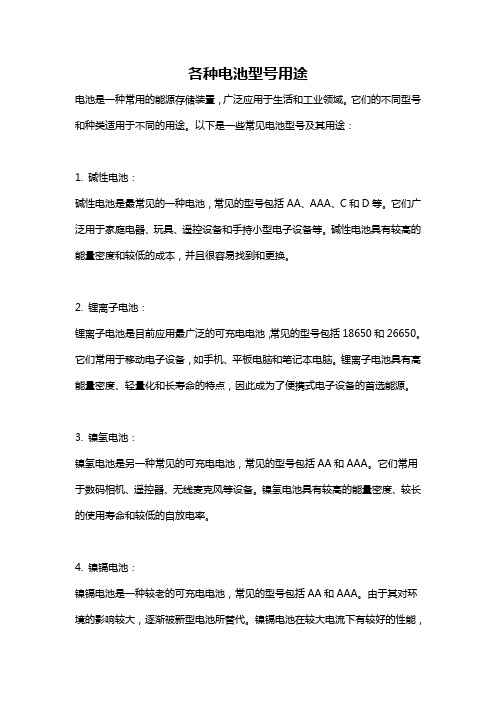
各种电池型号用途电池是一种常用的能源存储装置,广泛应用于生活和工业领域。
它们的不同型号和种类适用于不同的用途。
以下是一些常见电池型号及其用途:1. 碱性电池:碱性电池是最常见的一种电池,常见的型号包括AA、AAA、C和D等。
它们广泛用于家庭电器、玩具、遥控设备和手持小型电子设备等。
碱性电池具有较高的能量密度和较低的成本,并且很容易找到和更换。
2. 锂离子电池:锂离子电池是目前应用最广泛的可充电电池,常见的型号包括18650和26650。
它们常用于移动电子设备,如手机、平板电脑和笔记本电脑。
锂离子电池具有高能量密度、轻量化和长寿命的特点,因此成为了便携式电子设备的首选能源。
3. 镍氢电池:镍氢电池是另一种常见的可充电电池,常见的型号包括AA和AAA。
它们常用于数码相机、遥控器、无线麦克风等设备。
镍氢电池具有较高的能量密度、较长的使用寿命和较低的自放电率。
4. 镍镉电池:镍镉电池是一种较老的可充电电池,常见的型号包括AA和AAA。
由于其对环境的影响较大,逐渐被新型电池所替代。
镍镉电池在较大电流下有较好的性能,并广泛用于应急照明、动力工具和军事设备等。
5. 铅酸电池:铅酸电池是一种较为成熟的可充电电池,常见的型号包括6V和12V。
它们被广泛应用于汽车起动电池、不间断电源和太阳能储能系统等。
铅酸电池具有较低的能量密度和短的寿命,但成本相对较低,大电流放电能力较强。
6. 锂聚合物电池:锂聚合物电池是一种新型的可充电电池,常见的型号包括薄型电池片和软包电池。
它们被广泛应用于便携式电子设备、智能手表、无人机和电动汽车等。
锂聚合物电池具有更高的能源密度、更轻薄的设计和较高的安全性能。
此外,还有其他种类的电池根据不同的用途而开发,如太阳能电池、钴酸锂电池、银锌电池等,它们适用于太阳能发电、医疗设备、火灾报警器等特定领域。
总之,电池在我们的日常生活和工业生产中起到了至关重要的作用,不同的电池型号能够满足各种不同应用需求,提供便利和能源支持。
电池通用型号

电池通用型号:一站式了解常见电池规格与用途一、AA电池(五号电池)AA电池,又称五号电池,是日常生活中最常见的电池型号之一。
它的直径为14.5mm,长度为50.5mm。
AA电池广泛应用于遥控器、手电筒、闹钟、玩具等小型电子设备。
根据电量不同,AA电池可分为碱性电池、镍氢充电电池和锂电池等。
二、AAA电池(七号电池)AAA电池,又称七号电池,直径为10.5mm,长度为44.5mm。
它比AA电池更小巧,适用于MP3、MP4、耳机等小型便携式设备。
同样,AAA电池也分为碱性电池、镍氢充电电池和锂电池等。
三、9V电池9V电池,直径为17.5mm,长度为26.5mm,具有9伏的电压。
它主要用于烟雾报警器、无线门铃、电子玩具等设备。
9V电池同样有碱性电池和锂电池之分。
四、150电池150电池是一种圆柱形锂电池,直径为18mm,长度为65mm。
它的容量和放电性能较好,广泛应用于太阳能灯具、电动工具、移动电源等领域。
150电池具有较高的能量密度,是许多高性能电子设备的理想选择。
五、CR2032纽扣电池CR2032纽扣电池,直径为20mm,厚度为3.2mm,适用于智能手表、计算器、电子秤等小型电子设备。
纽扣电池体积小巧,电压稳定,但容量相对较小。
六、AAABattery(四号电池)AAABattery,又称四号电池,其直径为24.5mm,长度为50.5mm,体积较AA电池稍大。
四号电池常用于一些专业的电子设备,如闪光灯、某些型号的无线电通讯设备等。
它们通常有较高的容量和更长的使用寿命,适合耗电量较大的设备。
七、AAAA电池(八号电池)AAAA电池,又称八号电池,直径为8.3mm,长度为42.5mm,是这些常见电池型号中最细长的。
它们主要用于一些精密仪器,如血糖仪、小型遥控器等。
由于体积限制,AAAA电池的容量相对较小,但它们在特定设备中发挥着重要作用。
八、12V电池12V电池通常指的是汽车电池,它们为汽车提供启动电力,同时也为车内的电子设备供电。
电池分类及介绍

电池分类及介绍一、电池的分类:1、按工作性质及存储方式分:原电池,蓄电池,储备(激活)电池,燃料电池。
2、按电解质性质分:酸性电池,碱性电池,中性电池,有机电解质溶液电池。
3、固体电解质电池;按电池特性分:高容量电池,密封电池,免维护电池,防爆电池等。
4、动力电池的概念:电池输出的能量用于车辆(汽车、电动自行车等)牵引、驱动用途的电池。
二、19种电池介绍:1、锂电子电池:锂电子电池是一种新型、高效、安全和环保的电池类型,特别适用于电动车。
锂电子电池,也称为锂离子电池,由日本索尼公司于1990年首次推向市场。
2、燃料电池:燃料电池是一种新型动力电源,主要分为甲醇燃料电池和氢氧燃料电池。
其工作原理是利用燃料(如氢气、碳、甲醇等)和氧气在电池内部发生化学反应来产生电能。
3、蓄电池:蓄电池主要分为铅酸电池。
铅酸电池以其价格低廉和容量大为特点,是传统电动车电池类型。
它采用稀硫酸作为电解液,由二氧化铅和绒状铅分别作为电池的正极和负极。
4、碱性电池:碱性电池是以氢氧化钾溶液为主要电解质的电池。
这类电池包括碱性锌锰电池,也被称为碱锰电池或碱性电池。
除此之外,还有镍镉电池和镍氢电池等。
5、镍氢电池:镍氢电池是一种在二十世纪九十年代发展起来的新型绿色电池,具有高能量、长寿命和无污染等特点。
6、贮备电池:贮备电池是一种在储备时不直接接触电解液的电池,使用时才加入电解液或采用其他方法激活。
这种电池设计旨在延长电池的寿命和安全性。
7、一次电池:一次电池,也被称为原电池或干电池,是一种不能再次充电的电池。
这类电池包括锌锰电池和锂原电池等。
它们广泛应用于各种电子设备,如5号、7号和一次性扣式电池等。
8、镍镉电池:镍镉电池是一种以氢氧化镍和金属镉为化学品的蓄电池。
其优点包括储存能量时重量较小、充电效率高、放电时终端电压变化小、内阻小且对充电环境要求不严格。
9、酸性电池:酸性电池是以硫酸水溶液为主要电解质的电池类型。
这类电池包括铅酸蓄电池、锌锰干电池和海水电池。
动力电池产品分类
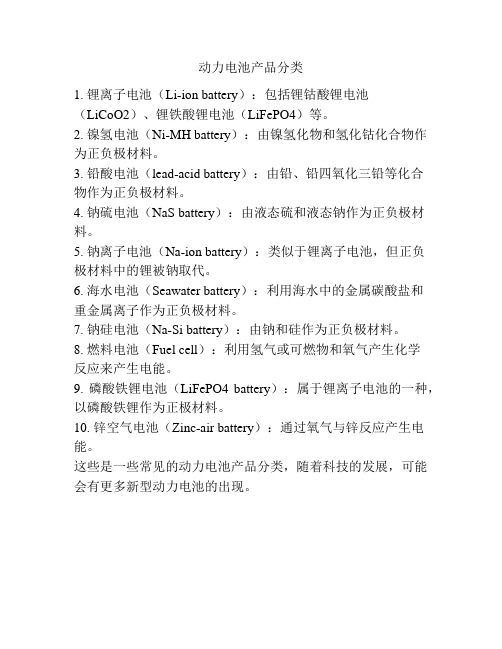
动力电池产品分类
1. 锂离子电池(Li-ion battery):包括锂钴酸锂电池
(LiCoO2)、锂铁酸锂电池(LiFePO4)等。
2. 镍氢电池(Ni-MH battery):由镍氢化物和氢化钴化合物作为正负极材料。
3. 铅酸电池(lead-acid battery):由铅、铅四氧化三铅等化合
物作为正负极材料。
4. 钠硫电池(NaS battery):由液态硫和液态钠作为正负极材料。
5. 钠离子电池(Na-ion battery):类似于锂离子电池,但正负
极材料中的锂被钠取代。
6. 海水电池(Seawater battery):利用海水中的金属碳酸盐和
重金属离子作为正负极材料。
7. 钠硅电池(Na-Si battery):由钠和硅作为正负极材料。
8. 燃料电池(Fuel cell):利用氢气或可燃物和氧气产生化学
反应来产生电能。
9. 磷酸铁锂电池(LiFePO4 battery):属于锂离子电池的一种,以磷酸铁锂作为正极材料。
10. 锌空气电池(Zinc-air battery):通过氧气与锌反应产生电能。
这些是一些常见的动力电池产品分类,随着科技的发展,可能会有更多新型动力电池的出现。
高倍率锂离子电池种类型号有哪些
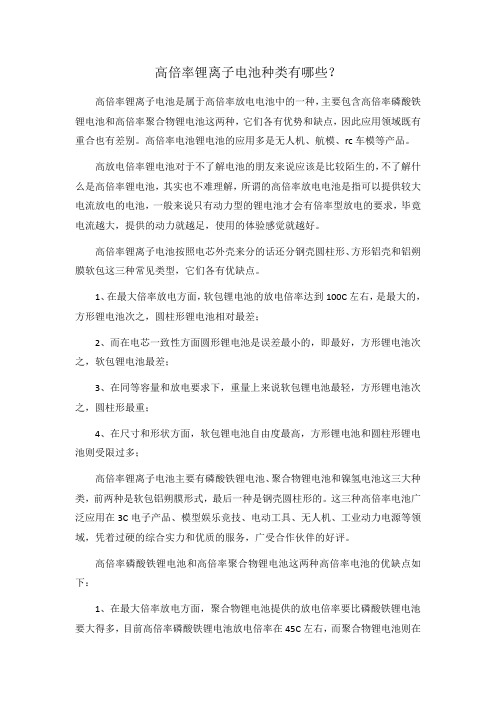
高倍率锂离子电池种类有哪些?高倍率锂离子电池是属于高倍率放电电池中的一种,主要包含高倍率磷酸铁锂电池和高倍率聚合物锂电池这两种,它们各有优势和缺点,因此应用领域既有重合也有差别。
高倍率电池锂电池的应用多是无人机、航模、rc车模等产品。
高放电倍率锂电池对于不了解电池的朋友来说应该是比较陌生的,不了解什么是高倍率锂电池,其实也不难理解,所谓的高倍率放电电池是指可以提供较大电流放电的电池,一般来说只有动力型的锂电池才会有倍率型放电的要求,毕竟电流越大,提供的动力就越足,使用的体验感觉就越好。
高倍率锂离子电池按照电芯外壳来分的话还分钢壳圆柱形、方形铝壳和铝朔膜软包这三种常见类型,它们各有优缺点。
1、在最大倍率放电方面,软包锂电池的放电倍率达到100C左右,是最大的,方形锂电池次之,圆柱形锂电池相对最差;2、而在电芯一致性方面圆形锂电池是误差最小的,即最好,方形锂电池次之,软包锂电池最差;3、在同等容量和放电要求下,重量上来说软包锂电池最轻,方形锂电池次之,圆柱形最重;4、在尺寸和形状方面,软包锂电池自由度最高,方形锂电池和圆柱形锂电池则受限过多;高倍率锂离子电池主要有磷酸铁锂电池、聚合物锂电池和镍氢电池这三大种类,前两种是软包铝朔膜形式,最后一种是钢壳圆柱形的。
这三种高倍率电池广泛应用在3C电子产品、模型娱乐竞技、电动工具、无人机、工业动力电源等领域,凭着过硬的综合实力和优质的服务,广受合作伙伴的好评。
高倍率磷酸铁锂电池和高倍率聚合物锂电池这两种高倍率电池的优缺点如下:1、在最大倍率放电方面,聚合物锂电池提供的放电倍率要比磷酸铁锂电池要大得多,目前高倍率磷酸铁锂电池放电倍率在45C左右,而聚合物锂电池则在100C左右;2、在安全性能和耐高温性能方面,磷酸铁锂电池要比聚合物锂电池更好;3、在低温性能方面,聚合物锂电池要比磷酸铁锂电池更好;4、在能量密度方面聚合物锂电池具有更高的能量密度;5、在生产制造成本上磷酸铁锂电池更低,原材料更加丰富;补充:电池标签上有电池容量、放电倍率等参数,其中所标的15C、25C、45C等这些表示的就是高放电倍率锂电池能提供稳定放电倍率(电流)的数据,比如那一个5000mAh,15C的电池来说,一般3C类电池产品如电子表、手机等这些使用的电池放电电流在0.2C到0.5C之间,即电流是1000mA到2500mA这样,如果是15C放电,那么电流就会达到75A。
铝碳电池和铝酸电池
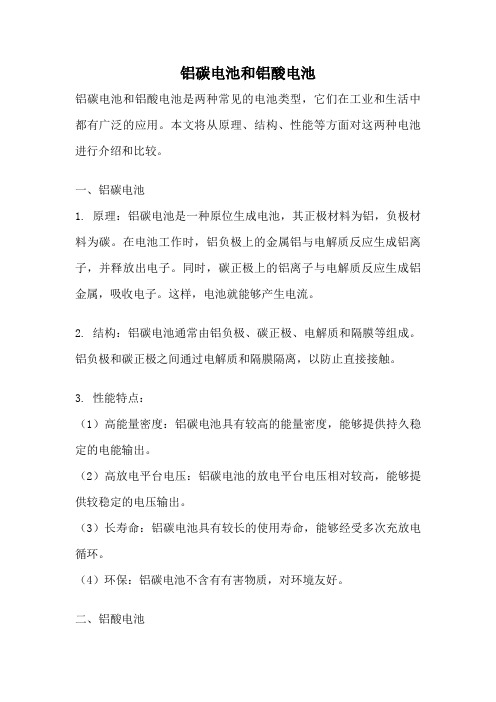
铝碳电池和铝酸电池铝碳电池和铝酸电池是两种常见的电池类型,它们在工业和生活中都有广泛的应用。
本文将从原理、结构、性能等方面对这两种电池进行介绍和比较。
一、铝碳电池1. 原理:铝碳电池是一种原位生成电池,其正极材料为铝,负极材料为碳。
在电池工作时,铝负极上的金属铝与电解质反应生成铝离子,并释放出电子。
同时,碳正极上的铝离子与电解质反应生成铝金属,吸收电子。
这样,电池就能够产生电流。
2. 结构:铝碳电池通常由铝负极、碳正极、电解质和隔膜等组成。
铝负极和碳正极之间通过电解质和隔膜隔离,以防止直接接触。
3. 性能特点:(1)高能量密度:铝碳电池具有较高的能量密度,能够提供持久稳定的电能输出。
(2)高放电平台电压:铝碳电池的放电平台电压相对较高,能够提供较稳定的电压输出。
(3)长寿命:铝碳电池具有较长的使用寿命,能够经受多次充放电循环。
(4)环保:铝碳电池不含有有害物质,对环境友好。
二、铝酸电池1. 原理:铝酸电池是一种氧化还原电池,其正极材料为铝,负极材料为铝酸盐。
在电池工作时,铝负极上的金属铝与电解质反应生成铝离子,并释放出电子。
同时,铝酸盐正极上的铝离子与电解质反应生成铝金属,吸收电子。
这样,电池就能够产生电流。
2. 结构:铝酸电池通常由铝负极、铝酸盐正极、电解质和隔膜等组成。
铝负极和铝酸盐正极之间通过电解质和隔膜隔离,以防止直接接触。
3. 性能特点:(1)高能量密度:铝酸电池具有较高的能量密度,能够提供持久稳定的电能输出。
(2)高放电平台电压:铝酸电池的放电平台电压相对较高,能够提供较稳定的电压输出。
(3)较短寿命:铝酸电池的使用寿命相对较短,经受充放电循环次数较少。
(4)环保:铝酸电池不含有有害物质,对环境友好。
三、铝碳电池与铝酸电池的比较1. 能量密度:铝碳电池和铝酸电池的能量密度相当,都能够提供较高的能量输出。
2. 放电平台电压:铝碳电池和铝酸电池的放电平台电压也相当,能够提供较稳定的电压输出。
3c对电池的要求

3c对电池的要求首先,电池需具备高能量密度。
高能量密度意味着电池能够在保持高性能的同时,提供更长的使用时间。
对于移动设备和电动车等需要长时间工作的装置来说,高能量密度是一个非常关键的因素。
这可以使电池满足用户对于持久续航能力的需求。
其次,电池需具备高功率密度。
高功率密度意味着电池可以在较短的时间内提供较大的输出功率。
这对于需要瞬间高能量输出的装置来说非常重要,例如电动工具和电动汽车等。
高功率密度可以确保电池在需要时能够提供足够的电能,满足设备的工作要求。
此外,电池还需具备良好的环境适应性。
电池的性能和寿命受环境温度、湿度和压力等因素的影响。
因此,电池需要能够在各种环境条件下正常工作,并保持较长的寿命。
特别是对于户外环境或极端工作条件下使用的设备来说,电池的环境适应性尤为重要。
此外,电池还需具备较长的使用寿命。
使用寿命是指电池在正常使用条件下可以提供可靠和持久的电能的时间长度。
对于一次性电池来说,使用寿命通常是指其能够供电的时间。
而对于可充电电池来说,使用寿命是指其能够进行多少次可靠的充电和放电循环。
一般来说,用户希望电池的使用寿命尽可能长,以减少更换或充电的频率。
此外,电池还需具备较低的自放电率。
自放电率是指电池在不使用时自然放电的速率。
电池的自放电率越低,其在闲置状态下保存电能的能力就越好。
对于经常需要长时间闲置或备用的设备来说,较低的自放电率可以确保电池在需要时能够提供足够的电能。
最后,电池还需具备较高的安全性。
电池的安全性是指其在充电和放电过程中不会产生过热、漏液或爆炸等危险情况。
特别是对于高容量电池和大功率电池来说,安全是一个非常重要的因素。
因此,电池的设计和制造需要采取各种措施,以确保其在正常使用过程中不会对用户和设备造成伤害。
综上所述,对于电池的要求包括高能量密度、高功率密度、良好的环境适应性、较长的使用寿命、较低的自放电率和较高的安全性。
通过满足这些要求,电池才能够为用户提供可靠、持久和高效的电能供应,以满足各种不同设备的需求。
- 1、下载文档前请自行甄别文档内容的完整性,平台不提供额外的编辑、内容补充、找答案等附加服务。
- 2、"仅部分预览"的文档,不可在线预览部分如存在完整性等问题,可反馈申请退款(可完整预览的文档不适用该条件!)。
- 3、如文档侵犯您的权益,请联系客服反馈,我们会尽快为您处理(人工客服工作时间:9:00-18:30)。
▪ Third-generation zinc-air cells (GEN 3), employ molded plastic cell housings sealed and joined with epoxy adhesives (Figure 3). Batteries using 30 Ah GEN 3 zinc-air cells were first fielded in 2003 as the BA-8180 (Figure 4). The BA-8180, a 12/24 V, 750 Wh battery used for battlefield power by dismounted units, is designed for moderate power (up to 50 W) and a service life of several months. It powers tactical radios for up to a week or more for typical duty cycles.
3C 產品的電池種類介紹
主講人: 劉進添
3C 產品的電池技術
為了因應功能愈來愈強大的 3C 產品,電池技術也 必須要不停地推陳出新,才能供應這一代愈來愈饑 渴、愈來愈耗電的 3C 產品。最常見的四種充電電 池 -- 鎳鎘、鎳氫、鋰離子和鋰聚合物到底有什麼不 同?各有什麼優點和缺點?在這篇裡嘗試著用網路
▪ 一次電池( primary cell ):僅能被使用一次的電池,無法 透過充電的方式再補充已被轉化掉的化學能,故稱為一次 電池。此類電池常見的有乾電池、水銀電池與鹼性電池等。 一次電池的應用最早也最為廣泛,市面上販售的不可充電 電池幾乎皆屬此類,如圖所示的鈕扣型水銀電池、1號、 2號以及3號電池等等。
▪ 燃料電池依電解質的不同,可區分為鹼液型(AFC)、磷酸 型(PAFC)、熔融碳酸鹽型(MCFC)、固態氧化物型(SOFC)、 質子交換膜型(PEMFC)、直接甲醇型(DMFC)等六種, 但反應原理大致相同。
效率高, 乾淨
▪ 傳統內燃機﹝發電機﹞要將例如煤、燃油、瓦斯等物質的 化學能轉變為電能的發電過程,是由燃料混合氧、先轉變 為熱能、機械能,再轉變為電能的複雜程序,因此一般只 有30%左右的效率。
反之,燃料電池的能量轉換效率非常高,它是利用輸入燃 料混合氧,不經過轉換機械能便能持續產生熱能及電力, 也不須傳統二次電池所需的充放電程序。以氫氣及氧氣為 燃料,利用觸媒加速反應速率,燃料電池可直接將化學能 轉變為電能,其效率可接近40%,若再包括回收餘熱,效 率更可輕易超過65%。而且只要正常使用下,燃料提供無 虞,目前依照官方說法並無使用時間上的限制。 ▪ 燃料電池的發電過程幾乎沒有造成任何污染。如果以11百 萬瓦燃料電池的發電廠為例,電廠運轉的氮氧化物排放量 為1PPM,也沒有硫氧化物及粒狀污染物,比目前最清潔 的天然氣發電廠還乾淨,同時具備低噪音、安靜等特色。
specific energy.
▪ Second-generation zinc-air (GEN 2) is the button-cell, commercialized in the 1970’s for hearing aids (Figure 2). With specific energies of more than 400 Wh/kg, the button cell is typically limited to about 10 mW in power and has a service life of one month.
▪ 二次電池( secondary battery ):二次電池所指的就是可以 被重複使用的電池。透過充電的過程,可以使得電池內的 活性物質再度的回復到原來的狀態,因而能再度的提供電 力。這類的電池有鉛酸電池 ( lead acid battery )、鎳鎘電 池 ( nickel cadmium battery )、鎳氫電池 ( nickel hydrogen battery )、二次鋰電池 ( secondary lithium battery ),以及鋰離子電池 ( lithium ion battery ) 和高分 子鋰電池 ( polymer lithium battery ) 等。
Safety
▪ One of the key safety concerns for battlefield equipment being bullet penetration, two of the batteries were taken to the sniper range at Marine Corps Base Quantico. Each was connected to a SINCGARS radio in transmit mode during its test.
上找得到的資料來分析給大家聽...
此外,若以電池中的電解液的酸鹼度來做區分,則 電池的種類又可以被分為鹼性、酸性以及中性電池 等。而上面所提及的都是將化學能轉換成電能的電 池,如果我們所使用的是太陽能,那就是屬於太陽
能電池 ( solar cell ) 了。
何謂一次電池, 二次電池?
▪ 電池的種類:關於ห้องสมุดไป่ตู้池的分類可以透過電池本身 的充放電特性與工作性質大致區分如下:
▪ Second generation the button-cell batteries for hearing aids. ▪ Third-generation zinc-air batteries are being developed as
a lightweight, low-cost, and safe battlefield power source for the dismounted warfighter. ▪ Fourth-generation zinc-air batteries are being developed for Army and Marine Corps missions requiring both high specific energy and power, incompact volume.
Zinc-Air Batteries
▪ First generation zinc air was the relatively heavy and lowrate batteries sold into the remote signaling markets (buoys, railroads),
▪ Both batteries got warm, less than 50 C above ambient, but neither exploded or caught fire.
太陽能電池(Solar cell)
▪ 太陽能的法力無邊, 其中:由於在地球上的日照不平 均, 所以造成冷熱溫度對流而生成風, 而風力亦可發電, 所以在 美國 風力發電 也歸太陽能源的一種.
燃料電池( fuel cell )
▪ 燃料電池( fuel cell ):與前述兩者有相當大的不同,又被 稱為連續電池。特色是陰陽兩極並無活性物質的存在,而 是透過外部的系統提供,所以只要持續地提供活性物質, 電池就可以持續的放電。在陽極部分,真正進行氧化反應 的是空氣或是氧氣;而陰極部分則是以氫或者是煤氣等為 主。此類電池如氫氧燃料電池 ( hydrogen oxygen fuel cell ) 等。此類電池尚在發展中,且受限於其較大的體積, 主要用在發電機組上或最為備用能源。近來由於技術的提 昇,有逐漸小型化的趨勢,並運用於電動車輛等領域。
▪ 此外太陽能的應用又可分為熱能的 "太陽能熱水器" 及光直 接轉換電的 "太陽能電池" , 目前較著重於 "太陽能 電池" 的應用推展.
▪ 一般所講的或能買到的太陽能光電池(Solar cell),並不同 於一般"蓄電池"(Battery)可儲存電能,而是有光源照射 的當時,才能將光能轉換為電壓與電能並可立即輸出的電 池(Cell),因其本身並非儲能蓄電池,故無法儲存電能
Prototype UAV Battery and Prototype MAV cell
First-generation zinc-air batteries (GEN 1), introduced in the 1950’s, resemble automotive SLI batteries in construction and are used in remote signal applications such as buoys and railroad crossings (Figure 1). They are designed for low-rate (< 1 A), multi-year service and have moderate
▪ The first took five rounds of 5.56 from an M-16, during and after which the radio continued to transmit.
▪ The second took one round of 7.62 from a Marine Corps sniper rifle, with the same result. A second round of 7.62 in each blew the upper part of the batteries off, at which time the radio ceased operation.
三種市場上流通的太陽能電池
Solar power plant
太陽能電力系統
Cylindrical Cell
Button Cell 1980s
Fuel cell powered bicycle lamp.
